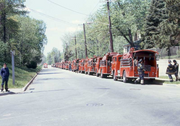Atlas said:82 & 85 were an interesting pair while in the same quarters. For a while they responded together 1st & 2nd due, or even third due. Other times one was held back in quarters for another box, & for a while they both were assigned to different boxes & would not respond together.
For a while, when The Bronx had three Squads ( # 1, #2, & #5) these units would rotate daily between different companies to try to give them a break.
Engines 512 (Engine 45) & Engine 513 (Engine 94), Ladder 712 (Ladder 31) were all used to give a break to the companies who's quartered that they responded from. After their tour of duty, they returned to their storage quarters & the crew when home until the next afternoon.
It's been awhile since this was posted by "Atlas". But for a moment, lets just add to this and remember, "we are talking NO computer aided dispatching". Just to get a feel of what it was like in those Fire Comminications Offices, lets just focus on the Bronx.
Phones were ringing continueously. People reporting fires from rubbish to building fires. Smoke seen by some from blocks away calling it in. Each and every phone call had to be answered. In addition pull boxes were coming in from the several circuits across the room. Each one had to be counted.
As "Atlas" said TCUs (Tactical Control Units) Eng 512, 513, and Lad 712, and they were activated from around 1500 hrs to 2400 hrs.
Squad 2, normally quartered at Engine 73/Ladder 42 would change firehouses for the night shift. One night w/E73, the next w/E82, the next w/E85. They would only respond to Working Fires after 0100 hrs.
After 1500 hrs (?) Adaptive Response went into effect. Send 2 Engines, 1 Truck, and a chief, unless numerous calls were recieved. Then it would be filled out with 3 Engines/2 Trucks, Rescue etc.
DRBs were boxes that a chief was not required to respond to.
There were Interchange Companies. Engine 82 would interchange with Queens Engines 295 or 297. Just to use this 82/31 firehouse as an example, some nights there would be Engine 295 acting 82, Ladder 31, TCU 712 that was an extra ladder in service from 1500 hrs to 2400 hrs. There was Squad 2 that responded on runs as an Engine company, and as a Squad for All hands, but only on All Hands after 0100 hrs. And prior to the Tin House there was Engine 85 with them along with the Battalion.
I have no idea how those fire dispatchers did it. With NO computer aided dispatching, these fire dispatchers handle a staggering amount of fires and incidents. In addition, as I tried to point out there were many variables that came into play. And as somebody mentioned earlier, even chiefs on the scene of fires had no idea who was coming in. A fire in one building might get Eng 295, TCU 512, Squad 2, TCU 712 and Ladder 31. A fire in that same building the next night might get Engine 85, TCU 513, Engine 297, Ladder 48, and Ladder 42. And the third night, another group of completely different companies. All for the same building on three different nights.
You got to wonder, how did those dispatchers ever do it. If you were one of them, you had to be "The Best Fire dispatchers in the World". "What a Great job you did" !!!

